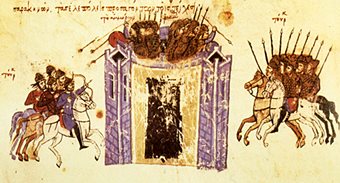
Sack of Amorium(Amorion) |
year: 83812 August 838 |
| The Arabs captured and razed the city, in an event that shocked Byzantium | ★ ★ ★ ★ ★ |
|
enemy: Arabs (Abbasids)
|
location: Amorium, the capital of the Anatolic theme (village Hisarköy, at the center of Afyonkarahisar Province in modern Turkey)
|
accuracy:
●●●●●
|
|
battle type: City Capture |
war: Byzantine-Muslim Wars |
modern country:
Turkey |
| ▼ The Byzantines(emperor: Theophilos) | ▼ The Enemies | |
| Commander: | General Aetios | Caliph Al-Mutasim |
| Forces: | 30,000 | 80,000 |
| Losses: | 70,000 soldiers and civilians dead | Minimal |
| Background story: |
| The Abbasid campaign was led personally by the Caliph al-Mutasim, in retaliation to an expedition launched by the Byzantine Emperor Theophilos into the Caliphate's borderlands the previous year. The Arabs targeted Amorium, because it was the birthplace of the ruling Byzantine dynasty and, at the time, one of Byzantium's most important cities and the capital of the Anatolic Thema. The Caliph gathered an exceptionally large army of 80,000 men, which he divided in two parts. One branch penetrated deep into Byzantine-held NW Asia Minor, while the northern army defeated the Byzantine forces under Theophilos at Anzen (Dazimon). After the battle in Anzen, the Arab armies converged upon Ancyra, which they found abandoned. After sacking the city, they turned east to Amorium, where they arrived on 1 August. Faced with intrigues at Constantinople and the rebellion of the large Khurramite contingent of his army, Theophilos was unable to aid the city. |
The Battle: |
 Arab siege of Amorium (Madrid Skylitzes) The Arabs concentrated their hits on this section, and after two days managed to breach the wall. The Byzantines defended the breach, but their position became hopeless. After about 2 weeks of siege, Aetios sent an embassy offering to surrender Amorium in exchange for safe passage of his people, but Mutasim refused. The Byzantine commander Boiditzes, however, who was in charge of the breach section, decided to conduct direct negotiations with the Caliph on his own. While he parlayed with the Caliph, the Arabs came closer to the breach, and at a signal charged and broke into the city. Taken by surprise, the Byzantines' resistance was sporadic: some soldiers barricaded themselves in a monastery and were burned to death, while Aetios with his officers sought refuge in a tower before being forced to surrender. The city was thoroughly sacked and plundered. It was burned to the ground, with only the city walls surviving relatively intact. The Caliph, due to a rebellion, had to cut short his campaign and return to his realm, taking many captives with him. General Aetios was executed. Several of the other prisoners were exchanged with Arab captives in a truce agreed in 841, but high-rank officers were exempt from this. After years of captivity and no hope of ransom, they were urged to convert to Islam. When they refused, they were executed at Samarra on 6 March 845, and are celebrated in the Eastern Orthodox Church as the 42 Martyrs of Amorium. |
Noteworthy: |
| The fall of Amorium inspired several legends and stories, and can be traced in surviving literary works such as the Song of Armouris or the ballad Kastro tis Orias ("Castle of the Fair Maiden"). |
Aftermath: |
| The sack of Amorium was one of the major events in the long history of Byzantine–Arab Wars. The military impact on Byzantium was limited, however. Mutasim, due to a rebellion, had to return to his realm. Ancyra and Amorium were reoccupied and rebuilt. Amorium was destroyed by Seljuqs in the 11th century, and that was its final destruction. |
|
|
